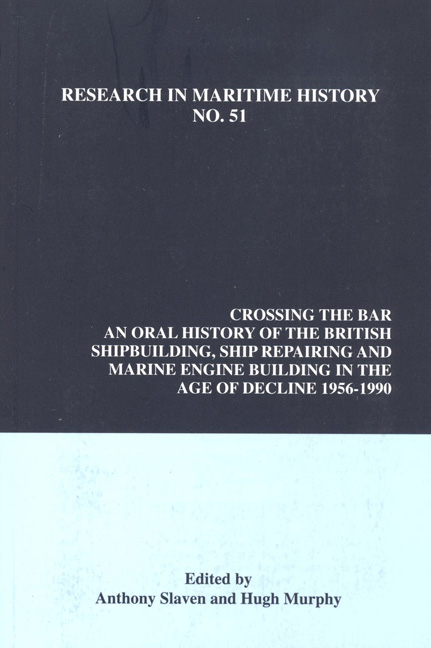 Crossing the Bar
Crossing the Bar Book contents
- Frontmatter
- Contents
- About the Authors
- Dedication
- Preface: A Shipbuilding Libretto
- Introduction
- Interviews
- Lower Clyde
- Upper Clyde
- The Tyne
- The Wear
- Barrow-in-Furness
- The South Coast
- The Humber
- 29 John Leathard, Richard Dunston, Hessle
- Belfast
- British Shipbuilding Industry Officials
- The Trade Unions
- The Civil Servants, Board of Trade, Shipbuilding Enquiry Committee, Shipbuilding Industry Board, Ministry of Technology, Department of Trade and Industry, Department of Industry
- The Politicians
- Interviews British Shipbuilders Plc
- Conclusion
- Select Bibliography
29 - John Leathard, Richard Dunston, Hessle
from The Humber
- Frontmatter
- Contents
- About the Authors
- Dedication
- Preface: A Shipbuilding Libretto
- Introduction
- Interviews
- Lower Clyde
- Upper Clyde
- The Tyne
- The Wear
- Barrow-in-Furness
- The South Coast
- The Humber
- 29 John Leathard, Richard Dunston, Hessle
- Belfast
- British Shipbuilding Industry Officials
- The Trade Unions
- The Civil Servants, Board of Trade, Shipbuilding Enquiry Committee, Shipbuilding Industry Board, Ministry of Technology, Department of Trade and Industry, Department of Industry
- The Politicians
- Interviews British Shipbuilders Plc
- Conclusion
- Select Bibliography
Summary
I started as an apprentice in the Neptune Yard of Swan Hunter in 1944, and began a course of study in naval architecture, graduating with an honours degree in 1947, and then got the 1851 Scholarship from the Institute of Naval Architects to do a research course for a further two years, which I did mostly at the National Physical Laboratory, Ship Division. On finishing there, I went back into the industry for a while with Thornycroft, but then left to work with the Northern Aluminium Company for three years, before moving to consulting naval architecture work with Bernard Collett and Partners. I stayed there for six years, before going to Richard Dunston on the Humber in 1961 as their Naval Architect. I progressed to Technical Director and General Manager to Managing Director leaving them in 1971 to join A…P Appledore International as a Project Director to start with, before becoming a Director.
Richard Dunston was a company, which had to build its reputation on a fairly restricted numbers of types of ships. For instance, I think it was the leading tug builder in the country. It was also quite a large builder of fishing vessels, and other work vessels like dredgers and small coasters. I think it had fallen behind, to some extent, on its design approach. I noticed that when I got there in 1961, that I felt that there were a lot of things that I could do to improve their designs. We tried to introduce them and after a while had an effective design office.
If we look at one of the failures of the company, and of the industry as a whole, the relationship between design and production was not looked at as effectively as it should have been. Design tended to be an end within itself. You did look at simple things, but this was done without any specific detailed approach, you just did it as an ad hoc arrangement. Nowadays there is a much greater understanding of the relationship between the two. If you start from scratch you should never put your pencil to paper before thinking of the effect of that on the design of the ship, but also on the construction of the ship. The two things must be considered together.
- Type
- Chapter
- Information
- Crossing the BarAn Oral History of the British Shipbuilding, Ship Repairing and Marine Engine-Building Industries in the Age of Decline, 1956-1990, pp. 125 - 128Publisher: Liverpool University PressPrint publication year: 2013
